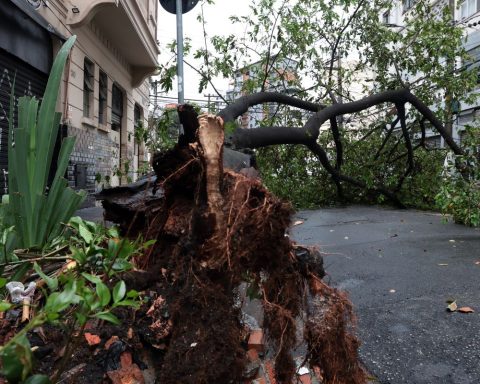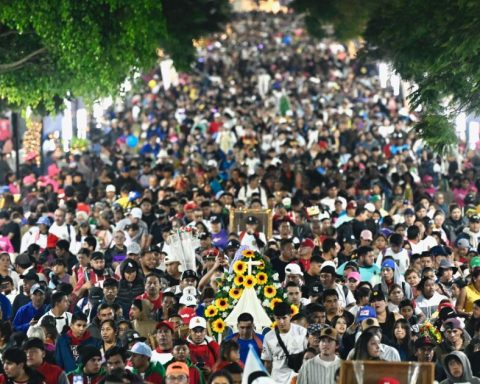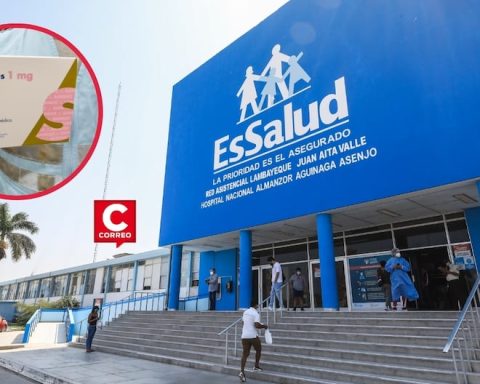The mythical Molino Building, on the corner of Callao and Rivadavia, in front of Congress, opened its doors to the public again this Friday to show the progress of its restoration, on the eve of its 106th anniversary and some 8,000 people toured its facilities.
The visitors, between 12 and 7 p.m., they were able to observe the progress of the Integral Restoration (RIEM) especially on the roof of the building, which was opened to the public for the first time since its closure in 1997.
The mythical building, the work of the renowned Italian architect Francisco Gianotti, was inaugurated on July 9, 1916, in commemoration of the Centennial of the Independence of Argentina.
The lines for the entrance occupied the entire block on Rivadavia avenue to access the first floor, ground floor and the first basement, and also on Callao to access the roof with people of all ages.
“My grandparents had their wedding party in 1961 in this place and I want to rediscover that space and compare it with the old photos I have. The building is very important architecturally and as an icon of the city”told Télam Franco Rodríguez Amato (19) a student of the career of History of the Faculty of Philosophy and Letters of the UBA.
In a climate of enthusiasm and curiosity, the visitors toured the rooms on the first floor and the confectionery located on the ground floor, where they enjoyed live music and visited the basement, where the old machines and kitchen ovens are.
They were also able to access the roof for the first time and see from there the dome that made an impressive visual game for being at the same height as that of the Congress.
The administrative secretary of the Commission in charge of the Comprehensive Restoration of the Mill Building (RIEM) Ricardo Angelucci said that they took on the job “with courage because it was a destroyed, looted building, with serious risks of collapse, plagued by vermin and rodents.”
(Photos Raul Ferrari)
And I add: “To see today that this can be enjoyed by people and also appreciated the beauty of each of its components is an enormous satisfaction of our collective work.”
Among the visitors were older people who were employees of the Confectionery, such as Isidro Ibañez, 90, who worked there for 37 years, from the mid-1950s to the late 1990s as a merchandise distributor.
“What I remember is that before 1955 the Confectionery was for a select public, of an elitist order, and after that year the mass of clientele began, an Italian immigrant or a Spanish immigrant could enter, they already had enough money to access the confectionery”.
Meanwhile, Ana Graciela León (66), a native of Formosa, began working at Confitería del Molino in 1989, going through the positions of salesperson, cashier and waitress until the place closed in 1997. Ana donated all the uniforms she had and treasured for more than 22 years in which the building was closed, and they were exhibited today in the confectionery.

“The owner always said that to work well we had to be a big family, we adopted each other. The day the Confectionery closed, it happened to many of us that we did not know what hurt us more: losing our jobs or separating us all, “he said.
And he added that “most of the staff were from different provinces of the country such as Chaco, Corrientes, Tucumán, Formosa, and with luck we had finished primary school, but they taught us many things here.”
“The house specialty was the Leguisamo dessert, the one that Gardel had commissioned for his friend Leguisamo”, which had a base of mille-feuille, dulce de leche, marron glacé and pionono.
Sandra Guillermo, coordinator of the Building Archeology team that recovered all the objects that were found in the three subsoils, highlighted that they have “impressive amounts of objects linked to confectionery” in the place.

“We also have products that were closed, such as bottles of Suter wine, closed canned cherries, canned tomatoes, which we do not intend to open so that they last, because they managed to be preserved and will remain in the future,” he explained.
“There is an issue that is key, which is the great social and political value that this building has, given that it is in front of the Palace of the National Congress. All the social and political life of our country in some way formed part of the life of this building, In fact, they called the Confectionery the Third Chamber, because many legislators gathered here to chat prior to the debate on the laws,” Nazarena Aparicio, one of the architects who participated in the restoration, told Télam.
The El Molino building responds to the Art Nouveau architectural style. Its main characteristics are ornamentation with the representation of human figures, the use of color in stained glass windows and ornamentation, curved motifs, without overloading.

All the work is carried out with employees of the National Congress and there is a restoration team working directly for the Commission with experts in the different supports that make up the building: stained glass, wood, metal, etc.
The cost of the restoration and enhancement is around 500 million pesos, Angelucci explained.
“The intention is to give public visits more regularity, with quotas of 8,000 people, which is what time allows so that people can spend more time enjoying themselves. The intention is to advance in the concession process by the end of the year.”

Among the personalities who passed through the Confitería del Molino were artists such as Nini Marshall and Libertad Lamarque; from the literary sphere Roberto Arlt, Leopoldo Lugones, Oliverio Girondo, Enrique González Tuñón; and political figures such as Joaquín V. González, Alfredo Palacios, Agustin P. Justo, Arturo Illia, Ricardo Balbín, Juan Domingo Perón, among others.
The delicacies with which the confectionery delighted its clients were: the meringues, the famous sweet bread, the caramelized almonds, the brown glacé, the Russian imperial, the leguisamo, the melba cup.
The next opening will be on Thursday, July 21. The visit will be with prior registration through the website (http://www.delmolino.gob.a) from Monday, July 18 at 12.
The news of the activities to be carried out in the monument can be seen through the official networks @delmolinook. The follow-up of the work can be seen under the hashtag used since the beginning of the tasks on July 2, 2018: #lavueltadelmolino.


















